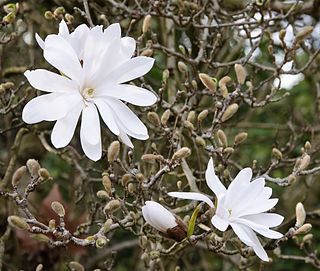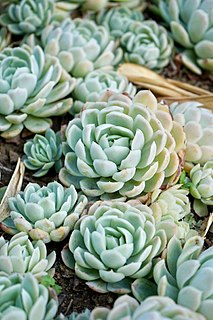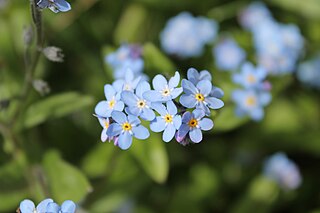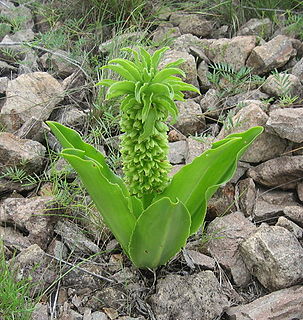
Alstroemeria, commonly called the Peruvian lily or lily of the Incas, is a genus of flowering plants in the family Alstroemeriaceae. They are all native to South America although some have become naturalized in the United States, Mexico, Australia, New Zealand, Madeira and the Canary Islands. Almost all of the species are restricted to one of two distinct centers of diversity, one in central Chile, the other in eastern Brazil. Species of Alstroemeria from Chile are winter-growing plants while those of Brazil are summer growing. All are long-lived perennials except A. graminea, a diminutive annual from the Atacama Desert of Chile.

Magnolia stellata, sometimes called the star magnolia, is a slow-growing shrub or small tree native to Japan. It bears large, showy white or pink flowers in early spring, before its leaves open. This species is closely related to the Kobushi magnolia, and is treated by many botanists as a variety or even a cultivar of that. However, Magnolia stellata was accepted as a distinct species in the 1998 monograph by Hunt.

Sempervivum is a genus of about 40 species of flowering plants in the family Crassulaceae, commonly known as houseleeks. Other common names include liveforever and hen and chicks, a name shared with plants of other genera as well. They are succulent perennials forming mats composed of tufted leaves in rosettes. In favourable conditions they spread rapidly via offsets, and several species are valued in cultivation as groundcover for dry, sunny locations.

Echeveria is a large genus of flowering plants in the family Crassulaceae, native to semi-desert areas of Central America, Mexico and northwestern South America.

Hyacinthus orientalis, the common hyacinth, garden hyacinth or Dutch hyacinth, is a species of flowering plant in the family Asparagaceae, subfamily Scilloidiae, native to southwestern Asia, southern and central Turkey, northwestern Syria, Lebanon and northern Israel. It was introduced to Europe in the 16th century. It is widely cultivated everywhere in the temperate world for its strongly fragrant flowers which appear exceptionally early in the season, and frequently forced to flower at Christmas time.

Primula elatior, the oxlip, is a species of flowering plant in the family Primulaceae, native to nutrient-poor and calcium-rich damp woods and meadows throughout Europe, with northern borders in Denmark and southern parts of Sweden, eastwards to the Altai Mountains and on the Kola Peninsula in Russia, and westwards in the British Isles.

Myosotis sylvatica, the wood forget-me-not or woodland forget-me-not, is a species of flowering plant in the family Boraginaceae, native to Europe. This spring-flowering plant and its cultivars, typically with blue flowers, are the familiar forget-me-nots of gardens.

Aeonium haworthii, also known as Haworth's aeonium or pinwheel, is a species of succulent flowering plant in the family Crassulaceae. It is grown as a houseplant in temperate regions. It has gained the Royal Horticultural Society's Award of Garden Merit, as has the cultivar ‘Variegatum’.

Erysimum cheiri, syn. Cheiranthus cheiri, the wallflower, is a species of flowering plant in the family Brassicaceae (Cruciferae), native to Greece, but widespread as an introduced species elsewhere. It is also treated as a hybrid under the name Erysimum × cheiri. It is widely cultivated as a garden plant.

Eucomis autumnalis, the autumn pineapple flower, or autumn pineapple lily, is a species of flowering plant in the family Asparagaceae, subfamily Scilloideae, native to Malawi, Zimbabwe and southern Africa. It is a mid to late summer flowering deciduous bulbous perennial. The flower stem reaches about 40 cm (16 in), rising from a basal rosette of wavy-edged leaves. The green, yellow or white flowers are arranged in a spike (raceme), topped by a "head" of green leaflike bracts. It is grown as an ornamental garden plant and can also be used as a cut flower.

Coprosma repens is a species of flowering shrub or small tree of the genus Coprosma, in the family Rubiaceae, native to New Zealand. Common names include taupata, tree bedstraw, mirror bush, looking-glass bush, New Zealand laurel and shiny leaf.

Echeveria elegans, the Mexican snow ball, Mexican gem or white Mexican rose is a species of flowering plant in the family Crassulaceae, native to semi-desert habitats in Mexico.

Olearia phlogopappa commonly known as the dusty daisy-bush or alpine daisy-bush is a species of flowering plant in the family Asteraceae that is commonly found in eastern New South Wales, Victoria and Tasmania. It is a small shrub with greyish-green foliage, daisy-like flowers in white, pink or mauve that can be seen from spring to late summer.

Lewisia cotyledon is a species of flowering plant in the family Montiaceae known by the common names Siskiyou lewisia and cliff maids. It is native to southern Oregon and northern California, where it grows in rocky subalpine mountain habitat.

Anemonoides blanda, syn. Anemone blanda, the Balkan anemone, Grecian windflower, or winter windflower, is a species of flowering plant in the family Ranunculaceae. The species is native to southeastern Europe and the Middle East. The specific epithet blanda means "mild" or "charming". The genus name is derived from the Greek word anemos, or wind.

Cyclamen coum, the eastern sowbread, is a species of flowering plant in the family Primulaceae. It is a tuberous herbaceous perennial, growing to 5–8 cm (2–3 in), with rounded heart-shaped leaves and pink shell-shaped flowers with darker coloration at the base. It is valued in horticulture as groundcover, and for the flowers which bloom in winter and early spring.

Echeveria agavoides, or lipstick echeveria, is a species of flowering plant in the family Crassulaceae, native to rocky areas of Mexico, notably the states of San Luis Potosí, Hidalgo, Guanajuato and Durango.

Echeveria derenbergii, the painted-lady, is a species of flowering plant in the family Crassulaceae, endemic to Mexico.

Crassula ovata, commonly known as jade plant, lucky plant, money plant or money tree, is a succulent plant with small pink or white flowers that is native to the KwaZulu-Natal and Eastern Cape provinces of South Africa, and Mozambique; it is common as a houseplant worldwide. Much of its popularity stems from the low levels of care needed; the jade plant requires little water and can survive in most indoor conditions. It is sometimes referred to as the money tree; however, Pachira aquatica also has this nickname.

Gasteria baylissiana, Suurberg gasteria, is a species of succulent flowering plant in the family Asphodelaceae, native to the Eastern Cape, South Africa.




















